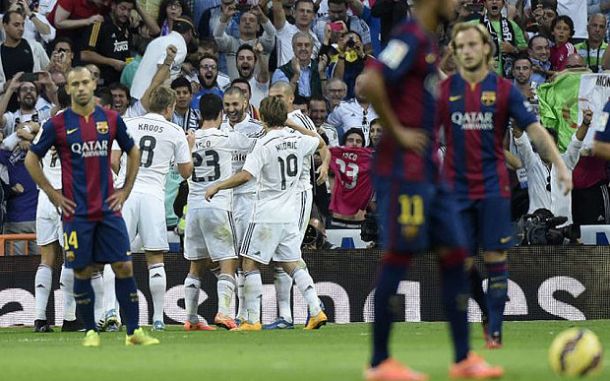October 25, 2014 MADRID – A limp Barcelona corner goes horribly wrong. The shallow delivery is swiped clear, leaving the graying Iniesta in a footrace with the youthful legs of Isco on the near sideline. Like a bar of soap, the Madrid man slips through the fingers of his pursuer to find Cristiano Ronaldo leading the charge of retreating Barcelona defenders. As he receives, Ronaldo cuts his first touch against the grain before spinning to supply the advancing Colombian, James Rodríguez. Now Benzema has joined the party too, sneaking through the outnumbered backline to collect James’ one touch pass and with a cross-body motion stuffs the ball inside the Claudio Bravo’s far post: 3-1. Poetry in motion to some, heresy to others.
Barcelona’s El Clásico wounds were still pooling with blood when the high priest of tiki-taka had his say on the scarring 90 minutes at the Bernabéu.
“They got that 2-1 from a corner and then they could play counterattack,” concluded Xavi in a condemning tone. What he wished to say said wasn’t totally cloaked by his comment, roughly translating to: “that’s not the proper way to play football.”
Xavi has propped himself atop the dizziest of football’s pedestals of style, representing the possession-obsessive methodology Pep Guardiola mastered at the Camp Nou, the mold that also shaped the most successful era in Spanish national team history. Videogame possession percentages, calculated buildups, and eye-crossing combinations tangled their way into the DNA of the Spanish game for good between 2008 and 2012.
So much that the word “counterattack” is scented by dirty connotation in Spain, almost as if it’s spoken with stale, ashy breath. It’s as good as any means of scoring, but its nature is tainted with want-away indecency; effective but shameful. It’s how the subordinate teams might have deployed once upon a time to scrape a point from gods; defend, defend, defend, and break. It’s branded as the tactical lower class. Antifootball.
Yet as tactical trends are finally turning the corner from Pep’s tiki-taka, multidimensional athletes top managers’ wish lists, hybrids that can possess and perspire. What once was an inferior antichrist to the offspring of Cruyff’s total football, the once unperfected counterattack has evolved into the multifaceted remedy to cure the oppression of possession.
Who deserves the credit for this new tactical roar, though? Heynckes Bayern Munich (2011-2013)? Perhaps Mourinho’s Real Madrid (2010-2013)? Probably a combination of both ingredients amongst others like Carlo Ancelotti, who has developed the final product – an amalgam that can explode forward and then keep it when they get there to seduce their prey.
In fairness to Xavi, you can see why it boils his blood. There’s Barcelona hoarding possession in their traditional manner, passing their way closer to an equalizer they feel they deserve, when Real Madrid unzips them! All it takes are 15 sexy seconds of sin from the time the corner is cleared until Bravo watches Benzema’s shot skip past his right hand. It was as if Xavi was meticulously erecting his house of cards when Madrid slammed the door, the gust decimating Barcelona’s tenacious persistence and attention to detail. For the last half hour, Barça would wander back through the motions and the card house’s scattered walls would never rebuild to their climax. The mojo was lost.
Characterized as the villain in the Clásico fixture since Barça started their alluring revolution in 2008, Real fans have been delighting in the swift pleasure of the counter for several seasons now. Seen through the eyes of culés, Real has been bathing in their own dirty fetish. Each match against the merengues is a showdown of styles, a crusade on the capital’s debauchery because the ghosts of central Spain have never abided by the rules of war.
But where brother Xavi has it wrong is that what Real Madrid do isn’t the cowardly cop out he scorns it to be. There’s honor in their advances after all. Firstly, Real have been known to do much more than counter this day and age. But by defending from deep positions at times, they are able to tempt opponents out of their own end and commit them to the attack. This butters up the space behind to break into with pacey outlets like Ronaldo, Bale, Benzema, etc, etc, etc.
It’s so easy to cast Real Madrid away with the demons, the ones who thump long balls to an athletic number nine fighting tooth and nail for that one breakaway. However, with Benzema’s recent Clásico goal serving as the example, Ancelotti’s unit breaks in colorful waves, like brush strokes. Each blurring swell forward careens and sharpens as its strands braid together in an abrupt masterpiece. The real evil is to denounce this artwork and ignore its solidarity from your run of the mill counter. Madrid can do persistently what no other team on Earth can, and even though it will never merge with the lineage of total football, these displays of footballing devastation should be exempt from the moral low ground on the merits of their artisanship.










































